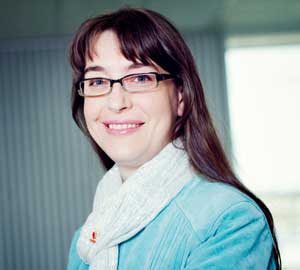Why do some women go into premature labour?
University of Lethbridge neuroscientist Dr. Gerlinde Metz has been searching for the answer for nearly a decade. Today, she is deepening her exploration with help from a new research grant, an international team of investigators and numerous student researchers at the University of Lethbridge.
Originally from Germany, Metz came to Canada purposely to conduct her research at the U of L's acclaimed Canadian Centre for Behavioural Neuroscience (CCBN). An expert on the physiology of stress, Metz is now a principal researcher at the CCBN, a professor in the University's Department of Neuroscience and a Senior Scholar of Alberta Innovates - Health Solutions (AIHS).
Metz is also a co-investigator on a new project that will examine various aspects of preterm birth. Led by University of Alberta researcher Dr. David Olson, the international group received more than $1 million in funding this fall from the Global Alliance to Prevent Prematurity and Stillbirth (GAPPS). An initiative of Seattle Children's, GAPPS supports innovative research and interventions to improve maternal, newborn and child health around the world.

Characterized by a gestational period lasting less than 37 completed weeks, a preterm birth is the most frequent cause of infant death and is a global health problem, according to a study released earlier this year by the United Nations, the World Health Organization, March of Dimes and Save the Children. In 2010, for example, approximately 15 million babies were born prematurely worldwide – and more than a million of those infants died. Survivors, meanwhile, can face a range of health issues, including cerebral palsy, developmental delay, and vision and hearing impairment.
While most premature babies are born in south Asia and sub-Saharan Africa, preterm births also occur in developed regions. In fact, Alberta has Canada's highest provincial rate for premature births, accounting for about nine per cent of babies.
That being the case, says Metz, it's fitting that her latest project involves two researchers from the province. Both Metz and Olson are members of the Preterm Birth and Healthy Outcomes Team, an interdisciplinary group of AIHS-funded researchers, who are advancing our understanding of premature labour.
"There are several steps that collectively cause labour to take place, but in a preterm birth situation, they start much earlier, and with significantly more risk to the mother and baby," Metz explains. "It's a complex problem that is surrounded by mystery. In half of all cases of preterm birth, there is no known cause, and in all cases, it is difficult to prevent preterm birth."

Working with her CCBN colleagues and a team of determined student researchers, Metz used laboratory rats to develop an animal model of spontaneous preterm birth. The goal: to learn more about the physiological factors behind the event, especially hormones.
"What we have learned so far is that there's a cascading effect which starts with an inflammation – or what the body thinks is an inflammation. This triggers white blood cells to go into defensive mode," she explains. "Members of our team have discovered that where there is a risk of preterm birth, the white blood cells respond differently to some type of change in the body. We will be looking at how to identify and reduce this inflammatory trigger."
To that end, she found that maternal stress experienced by one generation can affect the risk of preterm birth among offspring well into the future.
"This means that our focus isn't just on prenatal stress anymore," Metz says. "We're now looking at health and disease across generations."
Student researchers have played a key role in driving Metz's research forward. In addition to postdoctoral fellows, undergraduate and graduate students – as well as a particularly ambitious high school student – work with Metz in the lab. There, the students are learning the intricacies of academic research by handling a variety of responsibilities, such as developing ways to measure maternal health among rats.
"The students are putting together a puzzle," says Metz. "They are helping to solve the issues of tomorrow."
And their work is paying off. "The support we have received will advance our ability to hopefully change a large-scale health problem," she says. "It's really exciting for me, my colleagues at the CCBN and our students to be able to play a part. This is foundational research that could change how people generations from now live."
With the GAPPS funding through the University of Alberta, Metz will work with Canadian, Australian and Chinese researchers to explore four areas of study. First, the team aims to identify factors that lead to preterm birth. This information, in turn, will be used to help predict who is at greatest risk of the phenomenon. Next, the researchers intend to create new therapies to prolong pregnancy and prevent preterm birth. Specifically, Metz will test the effectiveness of peptides or molecules made up of amino acids.
Finally, the researchers hope to secure additional funding down the road in order to improve newborn health. The objective is to develop inexpensive and easily accessible tools for the early detection of preterm birth and treatments to delay it from happening. Both innovations are especially needed in low- and middle-income countries.
"Ultimately," Metz says, "we want to support healthy mothers and babies."
This story first appeared in the Fall 2012 issue of SAM. For a look at the full issue in a flipbook format, follow this link.
